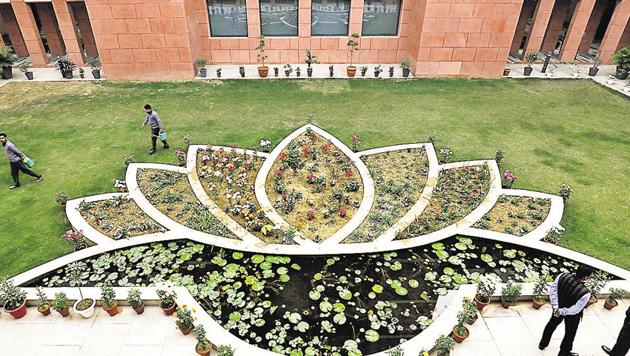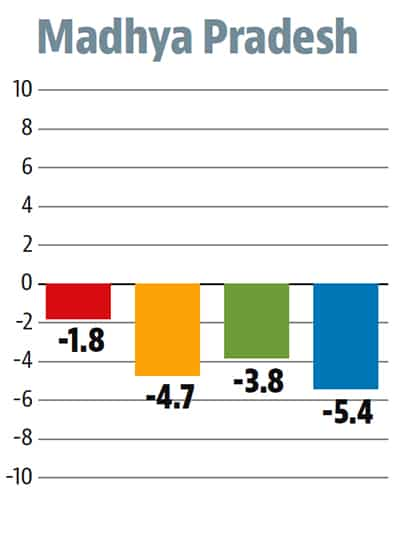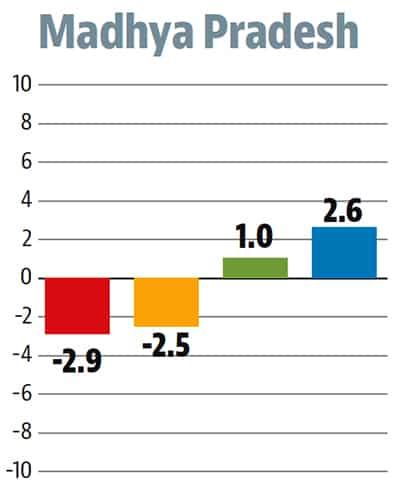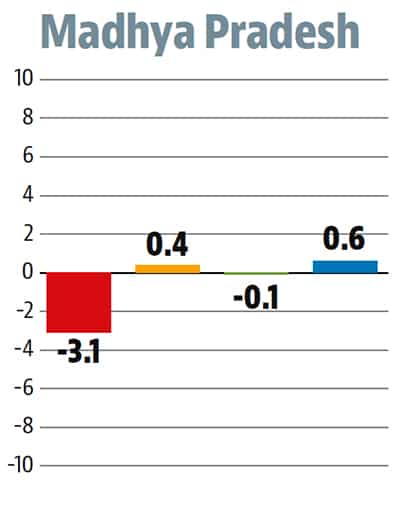Assembly Elections Results 2018: BJP losses cut across demographics
The Bharatiya Janata Party has seen a decline with urban and rural voters, farmers and non-farmers, and among scheduled castes and tribes.
The loss of the Bharatiya Janata Party (BJP) in elections in the key Hindi heartland states of Madhya Pradesh, Rajasthan, and Chattisgarh wasn’t on account of a single factor or one voter group voting against it but because of a secular decline with several voter groups consolidating into a significant anti-vote.

An analysis of the results shows that the BJP lost ground across urban and rural voters; farmers and non-farmers; and people belonging to the scheduled caste and scheduled tribe communities and those that don’t. Across each of these segments, and across all three states, the BJP lost vote share in the 2018 elections as compared to the 2013 ones. Put otherwise, its decline was secular.
This is important because in Rajasthan and Madhya Pradesh, the seat share gap between the Congress and the BJP is disproportionately higher than the vote share gap between them. There are two ways to understand why this has happened.
Click here for complete coverage of Assembly Elections and Results 2018
In a first-past-the-post system (FPTP), an improvement in the degree of opposition unity can lead to a reduction in seat share of a party even at similar levels of vote share. A pre-poll alliance is not the only way through which such opposition unity can be achieved. Voters could decide to consolidate behind the strongest challenger to ensure that the incumbent party is defeated. Looking at seat share to vote share ratio is a useful way to check whether this has happened. A comparison of these values for the BJP and Congress in the three states from 2003 onwards shows that BJP’s performance in 2018 is the worst in all three states. The numbers for the Congress are best ever in Madhya Pradesh and Chhattisgarh and second best in Rajasthan. This is really bad news for the BJP because it suggests that even without losing its existing voters its seat tally can suffer a dent. That’s exactly what happened.
Chart 1: Seat share to vote share ratio of BJP and Congress for 2003-2018

Who are the voters who realigned to ensure that the BJP did not come back to power? Merging census data with assembly constituency (AC) boundaries allows us to examine three possible demographic factors which could have played a role in such an anti- BJP consolidation. They are rural-urban population divide, agricultural-non agricultural workers’ share and the share of Scheduled Caste/Scheduled Tribe (SC/ST) population in a given AC. We have looked at quartile-wise vote share of the BJP and the Congress in each of these categories from 2013 to 2018. The BJP has suffered a secular decline in its vote share in each of these categories between 2013 and 2018.
See Chart 2: BJP’s vote share drops in last 5 years across professions and communities
a) Change in BJP vote share in rural-urban areas

Chart 2 b): Change in BJP vote share in agriculture/ non-agriculture areas

Chart 2 c): Change in BJP vote share in SC/ ST areas

There are some clear trends in the overall comparison of vote shares though. The Congress is ahead of the BJP in ACs with the highest share of rural population and farmers and agricultural labourers across all three states. In Rajasthan and Madhya Pradesh, the BJP is ahead of the Congress in the more urban ACs.
See Chart 3:BJP-Congress vote share difference in the 2018 assembly elections
a) Congress and BJP vote share in rural / urban areas

Chart 3 b): Congress and BJP vote share in agriculture / non-agriculture areas

Chart 3 c): Congress and BJP vote share in SC/ ST areas

Still, given the negative swings in its vote share across the board, the BJP would do well to not become complacent about its urban strongholds in the run up to 2019.



